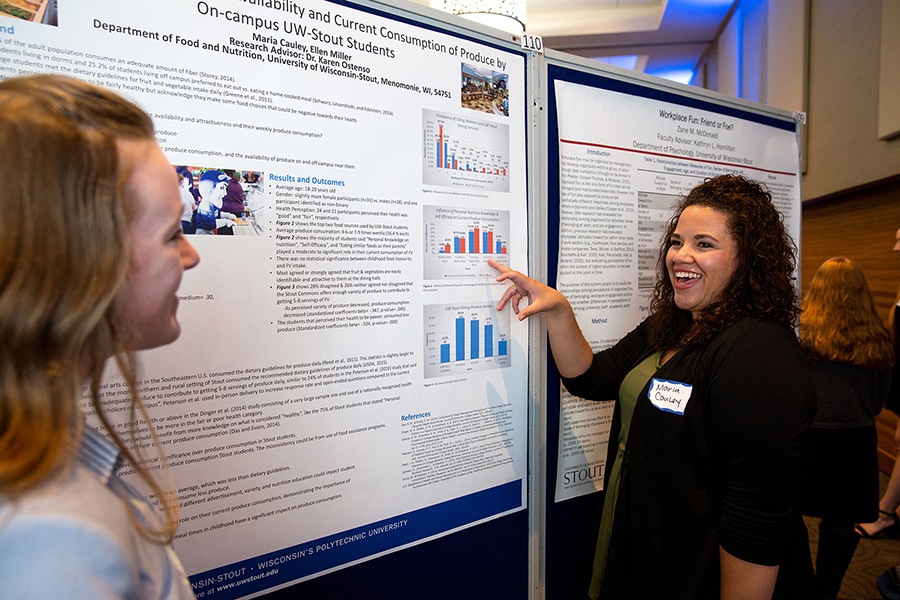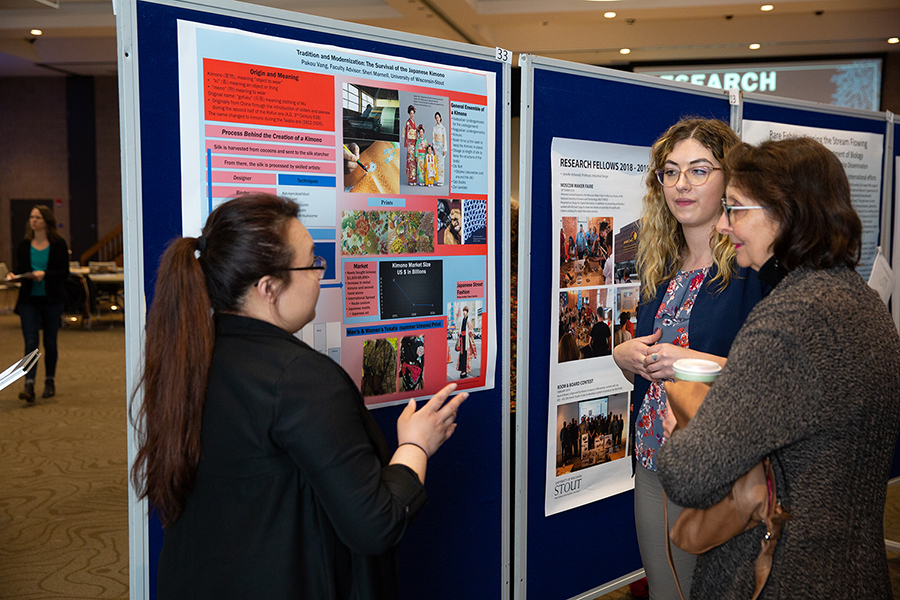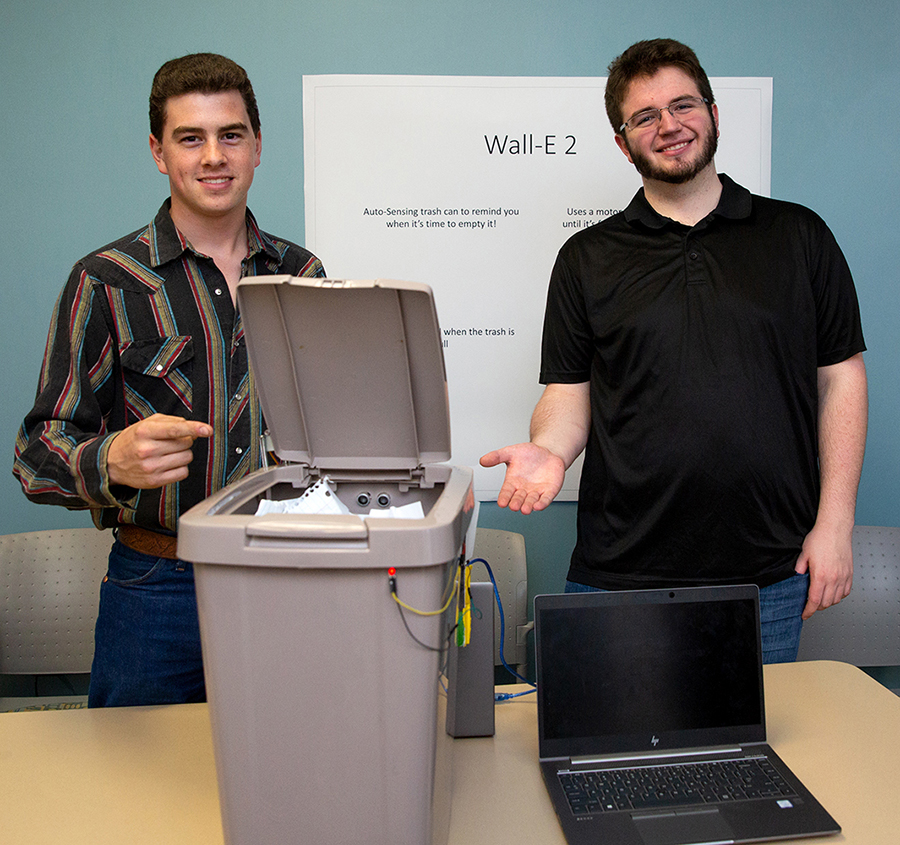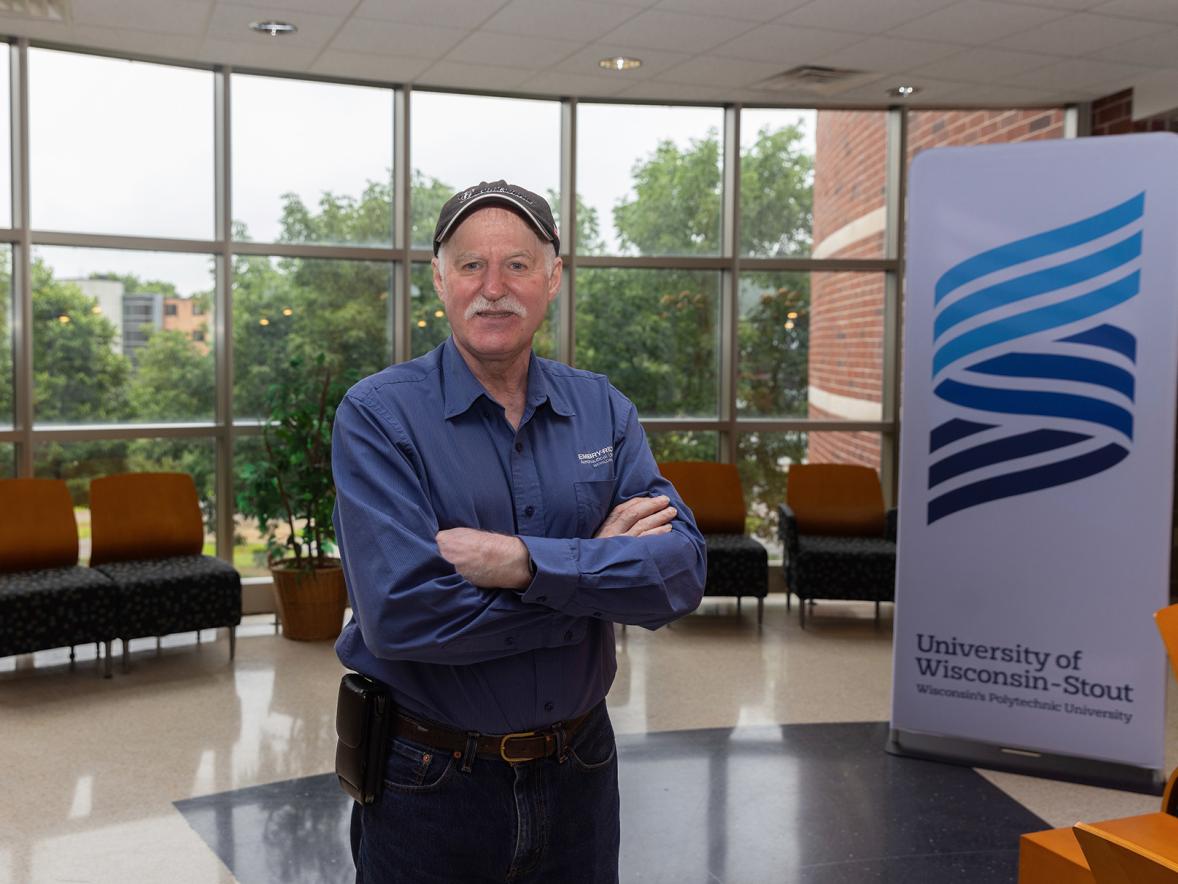Parents who worry if their college students are eating healthy are justified, according to research by two University of Wisconsin-Stout students.
Ellen Miller and Maria Cauley, graduate students in food and nutritional sciences, who graduate Saturday, May 4, studied how many fruits and vegetables UW-Stout students eat. The study, part of about 200 Research Day projects at UW-Stout on April 29, was entitled “Factors Influencing Perceived Availability and Current Consumption of Product by On-campus UW-Stout Students.”
Of 64 students surveyed most reported eating four to six or seven to nine servings of fruits or vegetables a week, far less than recommended. The U.S. Department of Agriculture recommends 22 or more servings of produce a week or five or more servings daily. Of the students surveyed only 1% consumed the recommended weekly amount of produce.
“It’s so low, it’ s like they are not eating one a day,” Cauley said.

Cauley, of Minnetonka, Minn., and Miller, of Racine, said they were a bit surprised by the findings, but one of the issues may be students don’t have enough knowledge about nutrition. “We need to have more education early on,” Cauley said.
Parents’ modeling of produce consumption and early exposure to fruits and vegetables also play a part in future consumption, they noted.
Another issue that seems to impact students’ intake of fruits and vegetables is if they perceive they are available and a variety of them are offered in an attractive manner. “They did say they didn’t think there was quite enough variety on or near campus available,” Miller said.
For example, Cauley noted if students go to Merle M. Price Commons cafeteria every day and see grapefruit and they don’t like it, they stop looking for other fruits. “I was surprised by that,” Cauley said. “I live on campus. I take advantage of the salad bar and fresh fruit on campus. But I have that knowledge and value system.”
They also believe more advertising and displays encouraging students to eat fruits and vegetables would help with consumption.
Part of the difficulty of having different varieties is during the winter they may not be available, Cauley said.
Culture could also play a role in consumption, they noted.
The next research step is to determine consumption levels at other campuses, Miller said.
Head injury, other research
Mary Cops of Kaukauna, who graduates in psychology, and Neal Wrobel, who graduates in interdisciplinary applied science, along with Isaiah Vang, a senior psychology major from Holmen, did research on “The Effect of Concussions and Repetitive Head Impacts on Balance.”
A total of 180 UW-Stout students were surveyed over the past several years on whether they had concussions and were tested on a balance board. The participants took the test with their eyes open, closed and while doing other mental tasks.
The conclusion was that concussions have a negative impact on balance, with athletes reporting having had head injuries showing greater sway on the board than those who had not. However, there needs to be more research on the subject. “The evidence suggests several years postinjury we still see deficits,” said Wrobel, of Rockford, Ill.

Joseph Kannel of Ellsworth researched what plastic material would work the best for a continuum manipulator for assistive technology to create a backbone of a flexible robotic arm. A problem with the arms is a flimsy backbone, the sophomore majoring in mechanical engineering said.
His research showed that PVC plastic, commonly used by plumbers for piping, would work the best because it retains its strength and rigidity. “The application is huge,” Kannel said, noting the goal is to create an affordable alternative for people that is safe and flexible.
Pakou Vang, a senior majoring in apparel design and development, researched “Traditions and Modernization: The Survival of the Japanese Kimono.” In 1975, 17 billion kimonos were sold compared to just two billion in 2016.
Vang, of Andover, Minn., has always had an interest in the traditional kimono, which are woven and hand-dyed or painted. Many of the traditional artisans who created them are aging, and the younger generations have not been interested in continuing the tradition because it takes a long time to learn the art form, Vang said.
“Interest in kimono-making as an occupation has declined,” she noted. “It is leading to the vanishing historical craft of making the kimono as the older generation who understands the art pass away due to old age.”
The introduction of newer types of kimonos that are comfortable and easy to wear may help to keep the traditional clothing in use, Vang said.
Students from the Engineering Technology 100 class also shared their research, which included automatic lawn mowers and garbage can sensors.

Trevor Valdez, of Knapp, and Bryant Ehlers, of Sturgeon Bay, designed a garbage can called the Wall-E 2 that closes when it is full. Ehlers, a first-year student majoring in computer and electrical engineering, said he noticed there was a problem with trash cans overflowing in the dormitories. Yet students would continue to try and stuff more garbage into them. Valdez, a first-year manufacturing engineering student, said a sensor is set off when the trash can is nearing capacity. It is easy to reset once the garbage has been emptied.
Nick Stroshane, a first-year plastics engineering major from Osceola, worked on a project developing a hearing hard hat. A sensor in the helmet alerts the user if noise levels require hearing protection. The helmet also alerts wearers when a horn is honked or there’s another loud noise; a light changes color, alerting wearers who might be wearing hearing protection to be aware of their surroundings. “We wanted to come up with an idea to help people,” he said.
Max Walker, a junior majoring in computer and electrical engineering from Florence, worked on a project to develop an autonomous lawn mower. He noted that most such lawn mowers now travel like a Roomba, not making rows people tend to like on their lawns. Sensors on the model would alert to obstacles in the row, and once the mower went around, it would return to the same row. “It seems like a really straightforward idea, but there are not a lot of them on the market,” Walker said.
Faculty, student awards
Research Day awards given April 29 to faculty and students included:
- Outstanding Senior Researcher of the Year, Lopa Basu, English and philosophy
- Outstanding Emerging Researcher of the Year, Jason Walter, social science
- Outstanding Student Researchers of the Year: College of Arts, Communication, Humanities and Social Sciences Emily Gordon, studio art; College of Science, Technology, Engineering, Mathematics and Management, Kayla Boyd, applied biochemistry and molecular biology; College of Education, Hospitality, Health and Human Services, Krystal DeGree, food science and technology.
Research Day, held annually at the Memorial Student Center, is hosted by the Office of Research and Sponsored Programs.
###
Photos
UW-Stout graduate students Maria Cauley, at right, and Ellen Miller discuss their research on college students’ nutrition.
Senior Pakou Vang talks about her research into traditional Japanese kimono making and how interest in the occupation has declined.
UW-Stout first-year students Trevor Valdez, at left, and Bryant Ehlers designed a garbage can that closes when it is full.





